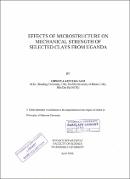Effects of microstructure on mechanical strength of selected clays from Uganda
Abstract
This thesis presents results of a study of the dependence of modulus of
rupture (MOR), Young's modulus, {.E), and flexural rigidity,{ DJ, of sintered
clay specimens on microstructure, average particle size and production
variables. The production variables considered were sintering time, sintering
temperature, and compaction pressure.
The study shows that the MOR, Young's modulus and flexural rigidity of the
clay product increase as compaction pressure, sintering temperature and
sintering time are increased, but decrease as the particle size increases for
all the processing conditions. The microstructure of clay specimens of higher
strength are such that, the pores are well rounded and fewer in number. The
grain boundaries are also thin and well defined with glassy phase being
dominant as compared to liquid and pore phases. Higher strength of the
clay specimens is also associated with formation of mullite which forms
needle-shaped crystals with an interlocking network that gives high stability
at elevated temperatures.
The variation between MOR and sintering time, t, can be described by a
relation of the form
MOR = ot2 + /3t + 9
where a, /3 and 9 are constants with some of their mean values for samples
compacted at 49.584MPa and sintered at 12oooc are: a = -0 .37±0.16MPas2,
/3 =4.93x0.87MPas·1 and 9 = 21.05±7.26MPa

